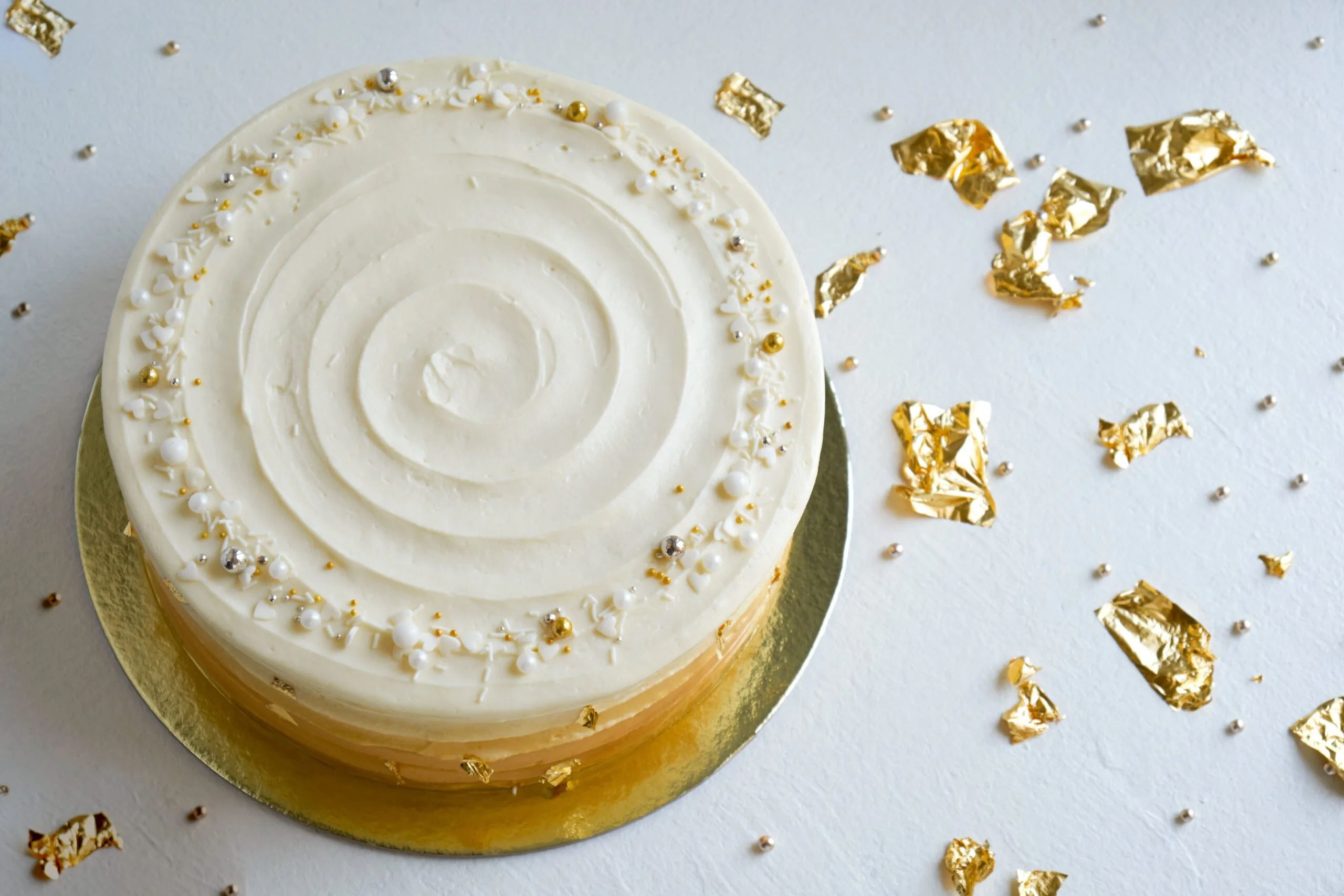Why do people eat gold? Because they can! While edible gold is not the most common use of precious metals, the trend has stood the test of time. From cakes and candies coated in edible gold leaf to decadent Philly cheesesteaks with gold flakes, gourmet dishes embellished with gold can be found around the globe.
Is Gold Edible?
Yes, gold is edible. Although it doesn’t have any nutritional value, gold can pass through the body without causing any harm. Because gold is chemically inert, it goes through the digestive tract without being absorbed at all.
But in order for gold to be edible, it must be pure. Edible gold ranges from 22 karats (91.67% pure) to a pure 24 karats. Food-grade gold is non-toxic and biologically inactive. This is why dentists have been using gold crowns for centuries, up to this day.
On the topic of dental gold, the European Food Safety Administration examined gold dental fillings during their reevaluation of the safety of gold as a food additive in 2015. They found that gold particles appear in saliva samples of people with gold fillings, so we can likely assume that as long as gold dental fillings have been around (a pretty long time), people have been swallowing gold particles without any adverse effects.
Because our bodies don’t absorb gold when we consume it, it’s purely used for a luxurious aesthetic. There’s a good chance you’ve seen photos of extravagant cakes adorned with gold leaf or even gold-wrapped sushi.
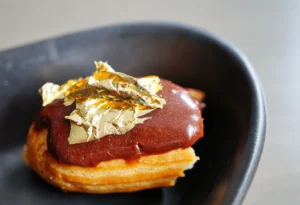
What Does Edible Gold Taste Like?
Edible gold has no taste at all – not even a metallic-y taste like one might expect. All you’ll taste when consuming edible gold is whatever else you’re eating it with.
Many chefs and bartenders use edible gold to add some sparkle to their creations. The Swiss cinnamon schnapps known as Goldschläger is one of the most well-known gold-containing spirits, with approximately 13 milligrams of gold per 1-liter bottle. (If you’ve ever thought about straining the gold flakes out of the schnapps to keep or resell, you’re not alone. But for such a trivial amount of gold, it’s not really worth the effort!)
You may also see edible gold flakes floating in a cocktail or resting atop a layer of egg white foam in a lavish libation. And when it comes to food, edible gold runs the gambit from sweet to savory. Think cakes, pastries, fine chocolates, fruit platters, sushi, steaks and more.
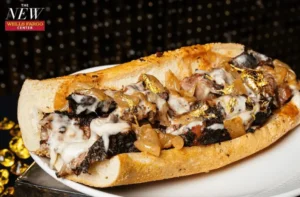
In an imaginary world with an unlimited dining budget, one could head to NYC for a $1,000 ice cream sundae topped with a sugar flower coated in edible gold leaf, or better yet go for the most expensive dessert ever – Serendipity 3’s Frrrozen Haute Chocolate. It only costs $25k!
But you don’t necessarily have to break the bank if you want to indulge in a gold-containing dish. Here in Philadelphia where Garfield is headquartered, you can grab a 24stK for $28 at the Wells Fargo Center at the next Sixers or Flyers game. The 24stK is a short-rib cheesesteak with smoked beef rib, truffle cheese sauce, caramelized onions, A1 demi sauce and flakes of 24k gold on a Liscio’s roll. Sounds like a must-try!
How to Use Edible Gold Dust
Edible gold dust is popular for decorating cakes and other pastries, garnishing cocktails, coating chocolate truffles, and ornamenting savory dishes like foie gras or steaks. Edible gold dust can be sprinkled or painted directly on top of food items, or mixed into doughs and batters to give baked goods a subtle shimmer.
Application methods of edible gold dust and edible gold glitter will vary depending on the visual effect you’re looking for. Dry application techniques include using a brush or simply sprinkling by hand.
Wet applications often involve mixing edible gold dust with a small amount of clear alcohol like vodka or Everclear, or an extract (like vanilla, lemon or coconut) to create an edible gold paint. The painting method works well for more precise designs, or covering large areas with a solid metallic coat.
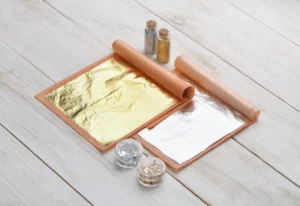
Using Edible Gold Leaf, Flakes & More
Because edible gold leaf sheets are so delicate, they can be tricky to use without the proper tools. Because it’s extremely thin, edible gold leaf can easily tear, wrinkle, or blow away if caught by a little gust of air (even just from your breath).
Gold leaf will also stick to your skin when touched, so it’s a good idea to wear cotton gloves while handling it. Other helpful tools may include a paring knife and/or a razor blade.
Using edible gold flakes sounds a bit more straightforward – they can simply be picked from the container and placed onto an item with tweezers. And last but not least there’s edible gold foil, which is very similar to gold leaf, but slightly thicker.
What About Silver?
While gold is the more popular edible noble metal, silver is also biocompatible and can be consumed. Just like gold, silver must be pure to be truly edible. One of the most common forms of edible silver is called ‘vark’ or ‘varak’ – a thin foil of pure silver used in South Asian cuisine, often with Indian sweets and confections.
How Much Does Edible Gold Cost?
Edible gold ranks among the world’s most expensive ingredients, up there with beluga caviar, saffron and truffles. But all in all, you can still find edible gold products at a pretty reasonable price. For example, we’ve seen 24k edible gold leaf priced at $26.50 for 10 sheets on the lower end. At first this sounds surprisingly cheap, but depending on which form of edible gold you’re buying, chances are it doesn’t amount to a significant weight of precious metal. Edible gold leaf sheets, for example, are incredibly thin – generally about 0.1 to 0.125 microns thick, which is thinner than a strand of human hair!
History of Edible Gold
Evidence of gold being used in food dates back to ancient Egypt, where people occasionally consumed gold as part of rituals to impart divinity from the gods. Historians think that Ancient Egyptians may have also believed that gold had medicinal or healing powers, so they’d consume small amounts for health benefits.
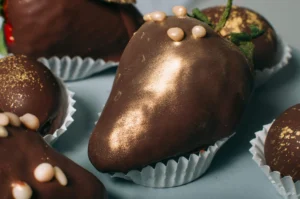
In ancient Japan, gold was used similarly to how we use it today – as a garnish on foods and drinks. Sake bottles contained gold flakes and special dishes were sprinkled with edible gold dust. Fast forward to the Middle Ages and edible gold arrived in Europe, where it was used to decorate fancy dishes at banquets. Even Queen Elizabeth’s table had fruits like oranges, pomegranates and dates dusted with gold powder.
Today, gourmet chefs and award-winning bartenders, cake designers and chocolatiers around the world still use edible gold to make bold culinary statements. These days anyone can purchase edible gold (and silver!) online in many shapes and forms.
Safety First
As mentioned before, gold must meet a purity level of at least 22k in order to be safe for consumption. And if an edible gold product is 22 karats, the remaining percentage should be comprised of another safe metal (silver). If you’re interested in purchasing edible gold for your own culinary endeavors, take time to vet the vendor and make sure that the product is truly non-toxic and safe. While it definitely sounds cool, Garfield does not recommend eating significant quantities of gold, silver or any other precious metals. We do, however, recommend investing in precious metals!
A Special Use of Gold
Humans have come up with tons of interesting ways to use gold throughout history, from ancient burial masks to art, coinage, jewelry and even beautifying our food. When you think about it, it’s only natural that we’ve luxuriated our meals and desserts with gold. People will go to great lengths for an elevated dining experience!
The use of edible gold will likely persist for years to come, as our fascination with gold has. At Garfield Refining we’ve spent a lot of time working with and learning about gold. Our take as a precious metal refinery? It might be fun to try edible gold once or twice, but ultimately, gold is better off being sold for scrap than eaten – this way the precious metal gets recycled and can take on a new life!
Stay tuned to our blog for more insights on precious metals! Check out other fun articles like 5 Fun Facts About Silver, The Uses of Gold in Electronics, and Is Gold Rare in Space?
Established in 1892, Garfield will get you the most for your gold, silver, platinum, and palladium, and we offer the industry’s best customer service. Consider selling your precious metal scrap? Start your free shipment today!

